ArtReview sent a questionnaire to artists and curators exhibiting in and curating the various national pavilions of the 2015 Venice Biennale, the responses to which will be published daily in the lead-up to the Venice Biennale opening.
Helen Sear is representing Wales as a collateral event. The pavilion is on Santa Maria Ausiliatrice, Castello, 450 (Fondamenta San Gioacchin).
What can you tell us about your exhibition plans for Venice?
Ideas of mortality and temporality are explored through a suite of new works in which agricultural landscapes marked for production and consumption are seen to exist simultaneously as magical spaces, imprinting themselves on the body and mind of the viewer.
The photographic and video works explore the image as sculptural form integrating different speeds of looking, contrasting physical scale, colour and vivid material presence. The works resonate strongly with each other and with the architectural site of the exhibition.
A key moving image work in the exhibition is the culmination of a yearlong study of a small beech wood in Monmouthshire and typically explores my working method of returning time and time again to a particular site to uncover the extraordinary within the familiar, to re-present the nature of experience.
Are you approaching this show in a different way as to how you would a ‘normal’ exhibition?
Not at all
What does it mean to ‘represent’ your country? Do you find it an honour or problematic?
My grandmother was a New Zealander, my grandfather a French Trinidadian and my parents moved around a lot when I was a child so have never had a strong sense of ‘my country’.
Wales is my adopted country, and since first moving here in 1984, has been both my inspiration and locus of production for 20 years
I would rather call myself a representative of Wales. Wales is my adopted country, and since first moving here in 1984, has been both my inspiration and locus of production for 20 years. I am deeply honoured to have this acknowledged at such a prestigious event.
How are you addressing the different audiences who come to Venice – the masses of artist peers, gallerists, curators and critics concentrated around the opening and the general public who come through over the following months?
My work is made from the heart and never with a particular audience in mind. I am more interested in how the audience experiences the work at a pre-conscious level. I am working with a fantastic team who are working towards gaining the widest possible exposure and interpretation for the work, both in Venice and Wales.
What are your earliest or best memories of the biennale?
Runa Islam, Pae White, Annette Messager, and drinking gin and tonic with the late, wonderful Alan Haydon and his wife Cat, who had invited myself and Andreas Ruethi to the Vernissage in 2011. Finally getting completely lost after the legendary 2005 Welsh party with artists Laura Ford, Peter Finnemore, Paul Granjon, Bedwyr Williams and Gruff Rhys of Super Furry Animals.
You’ll no doubt be very busy, but what else are you looking forward to seeing?
Joan Jonas, Fiona Hall, Sarah Lucas.
How does a having a pavilion in Venice affect the art scene in your home country?
Benefits and opportunities are reflected back into Wales through the strategic commissioning of Cymru yn Fenis/Wales in Venice exhibitions and related programmes; including Invigilator Plus, Travel Bursaries provided by Wales Arts International, educational resources as well as talks, events, links, and where appropriate, a re-staging of the exhibition produced for the Biennale back in Wales. The Venice Biennale is critically important for the profile, reputation and future careers of artists selected to represent Wales and for the image of Wales as a country that seeks to promote its contemporary culture worldwide, distinguishing Wales’ cultural profile with high quality art.
The exhibition from Wales is commissioned and managed by the Arts Council of Wales with support of grant in aid from the Welsh Government. The partnership between the Arts Council of Wales and Welsh Government is an excellent example of how we work closely to achieve our vision of Wales as a culturally vibrant nation. In a devolved Wales and at a time of great economic constraint, it is vital that the country’s creativity continues to register on the world stage.
Read all responses to the Venice Questionnaire 2015 edition published so far.
Read all 30 responses to the Venice Questionnaire 2013 edition.
Online exclusive published 10 April 2015.
